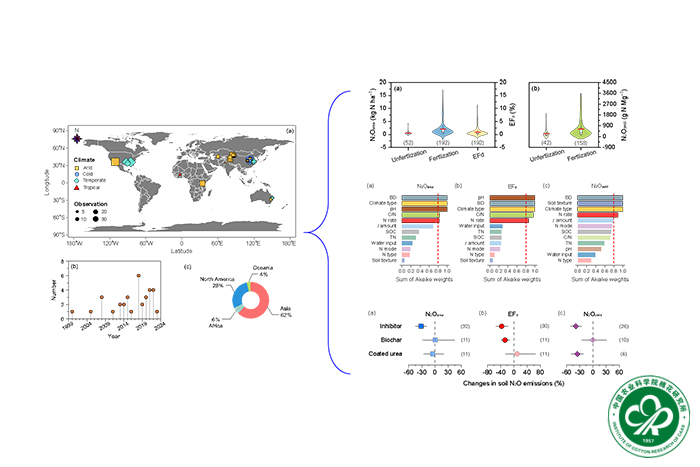- Location : Home» Newsroom
A global synthesis of nitrous oxide emissions across cotton-planted soils
Recently, the research entitled “A global synthesis of nitrous oxide emissions across cotton-planted soils” has been published by Sustainable Production and Consumption (IF = 0.9). In this paper, a researcher at the Cotton Research Institute of the Chinese Academy of Agricultural Sciences, collected, analyzed and excavated the data of nitrous oxide (N2O) emissions from cotton fields, and for the first time identified the intensity and control factors of N2O emissions from cotton fields in the world, and evaluated the corresponding emission reduction measures.
In this study, resercher were the first to synthesize 34 peer-reviewed papers (298 observational datasets) to quantify the magnitudes and controlling factors of area-scaled N2O emissions (N2Oarea), direct N2O emission factors (EFd), and yield-scaled N2O emissions (N2Oyield) from the soils of cotton fields and to explore associated potential mitigation strategies. On average, the N2Oarea from global cotton-planted soils was 2.10 kg N ha−1, with a mean EFd of 0.92 %, which is comparable to those reported for cereal crops (e.g., maize, 1.02 %) and the Intergovernmental Panel on Climate Change default value of 1 % for global croplands. The global mean N2O yield estimated here was 622 g N Mg−1. At the global scale, the variations in all N2O-related indices in the soils of cotton fields were demonstrated to be primarily controlled by climatic conditions (e.g. climate type) and soil properties (e.g., bulk density, pH, C/N or soil texture) rather than by well-recognized management practices (e.g., N fertilization rate). Furthermore, our analysis showed that the application of urease and/or nitrification inhibitors significantly reduced soil N2O emissions while maintaining seed cotton yields. These findings emphasize that cotton production has an obvious climate footprint and provide potential N2O mitigation options for the sustainable intensification of cotton production.
This research was financially sponsored by the Science and Technology Development Program of the Pilot Zone for Innovation-Driven Development along the Silk Road Economic Belt and the Wu-Chang-Shi National Innovation Demonstration Zone (2023LQJ03); the ‘Tianshan Talent’ Training Program: Research on Carbon Sink Function of Cotton and Carbon Label Creation of Cotton Textile under the Background of Carbon Peak and Carbon Neutrality (2023TSYCCX0020); the Natural Science Foundation of Xinjiang Uygur Autonomous Region (2022D01B224); and the Changji station of National agriculture and rural long-term factors comprehensive observation.
https://doi.org/10.1016/j.spc.2024.09.022
